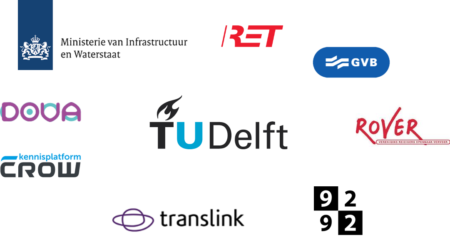About the Seamless Personal Mobility Lab
In this research and design lab, students and researchers of Industrial Design Engineering at TU Delft work together with transport operators, mobility companies, government and technology developers to get a better understanding of the wants, needs and behaviour of travellers.
We will explore the future of TRIP-platforms (Ticketing, Reservation, Information, and Planning) and how new transport modalities can be integrated in current personal mobility ecosystems. The two main themes connecting the different topics are Mobility as a Service (MaaS) and Seamless Travelling. The starting point for each project is the end user, in this case the traveller. We will identify the critical use factors and explore what would be the ideal user experience for future personal mobility services.
Our approach

User-centred
Taking the user as a starting point. It means we first explore what the user’s motives, needs, and wishes are. Next we use these outcomes to identify possible solutions and find the proper business models and technologies.
Qualitative
To understand the user’s motives, needs and wishes we want rich data, therefore most of our research methods are qualitative. Examples are interviews, observations or focus-groups. This way we do not only find data which the users is consciously sharing, but also learning from unconscious behaviour and actions.
Design research
Not only do we study the user and context before designing, we also test our concept with users and other stakeholders involved. Through physical or virtual prototypes, video’s or scenario’s, we gather feedback on new ideas and improve them accordingly. This triggers an iterative design process where we revise the ideas based on the data from end-users and stakeholders.
From E-ticketing in Public Transport to Service design in Personal Mobility
The Seamless Personal Mobility Lab is the successor to the Expertise Centre for E-ticketing in Public Transport.
The first phase of this expertise centre was called the ‘OV-chipkaart Graduation Lab’ and in this stage, the efforts were mostly conducted at analysing the issues at hand and improving the current system. Under the supervision of experienced design researchers, three graduation students analysed the usability of the Dutch OV-chipkaart system and benchmarked it against the systems in London and Hong Kong. In individual design projects they subsequently developed solutions for the usage problems that they had identified, such as visualising traveller status information, making checking in and out more fluent, and improving card acquisition and service provision. A design vision was developed for a more usable OV-chipkaart in the near future.
Expertise Centre for E-ticketing in Public Transport (X-CEPT). In the second phase the name changed to reflect that the focus was now also on the future of public transport ticketing. Apart from graduation students, now also researchers were involved. A number of projects still focused on solving current challenges of the OV-chipkaart, such as the user experience for international air travellers to the Netherlands, border crossing train ticketing and preventing missed check-outs at open payment boundaries. But we also explored how in the (near) future the bank card could be integrated successfully in the OV-chipkaart system, how mobile ticketing should be implemented to offer a satisfying user experience and how a new generation of access gates could offer superior passenger flow and user experience.

Seamless Personal Mobility Lab. This is the third phase of the expertise centre, focused on service design for smart personal mobility. The name has changed to reflect that the focus is not only on public transport, but on the integration of public, shared and individual transport: seamless personal mobility. Applying the same user-centred and integrated approach as in previous projects, with new multi-disciplinary stakeholder consortia consisting of transport operators, governments and technology partners, around different topics. Visit Projects to learn more about our current research and design activities.

